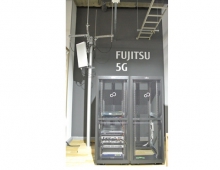
Fujitsu to Realign LSI Business
Fujitsu announced today its decision to pursue the reorganization of its LSI business divisions into a new subsidiary scheduled to be established within March 2008.
The decision was approved at a Board of Directors meeting held on Monday. The new subsidiary will enable Fujitsu to accelerate the growth of and intensify its focus on its ASSP business in addition to its ASIC business, according to Fujitsu.
Fujitsu also announced that development and mass-production prototyping of its advanced process technologies for the 90nm-generation and beyond will be consolidated to its Mie plant located in Mie prefecture of central Japan, a decision that was also approved at the Board of Directors meeting. Leveraging this consolidation, Fujitsu will strive to accelerate development of process technologies for 45nm-generation and beyond.
The reorganization is scheduled to be implemented in March 2008.
Standard logic LSIs prior to 0.13micrometer generation are manufactured on 150mm and 200mm wafer lines at fabs located at Fujitsu's Aizu-Wakamatsu plant, Iwate plant, and Mie plant in Japan. Advanced logic LSIs for 90nm-generation and beyond are manufactured on 300mm wafer lines at the Mie plant.
As part of Fujitsu's initiative to structurally reform its LSI business, advanced process technology development for 90nm-generation and beyond, and 90-nm-generation logic LSI mass-production prototyping, functions which have thus far been conducted at the Akiruno TC, will be transferred to the Mie plant.
The Akiruno TC was established in July 2000 as a development site for advanced LSI technologies, centralizing the LSI development and design divisions of the Fujitsu Group. Development and prototyping began on Akiruno TC's 200mm wafer line from December 2001. Ultra-low power and ultra-high end logic LSIs based on 90nm-generation process technology developed at Akiruno TC have achieved market success, and Fujitsu will hereafter continue to build on these advantages. Development of 90nm- and 65nm-generation process technologies has been successfully completed at Akiruno TC and LSIs featuring these technologies are currently being manufactured at the 300mm wafer line at the Mie plant.
Given that manufacturing on 300mm wafer lines is ideal for development of 45nm-generation process technologies, by shifting development that was based on 200mm wafer lines at Akiruno TC - which functions as a device development center - to the Mie plant, Fujitsu will accelerate its development of process technologies for 45nm-generation and beyond and maintain mass production adaptability.
Transfer of manufacturing equipment to the Mie plant is scheduled for March 2008. 45nm-generation process technology development is currently being shifted to the Mie plant, with transfer scheduled to be completed within the first half of fiscal year 2008 (April September 2008).
Regarding Media Reports on LSI and HDD Businesses,/b>
Fujitsu also today replied to various reports in the media, claiming that that Fujitsu was planning to collaborate with Toshiba and NEC Electronics on the development of LSI manufacturing technology. The Japanese company said that it did not have such a plan.
Fujitsu also said that it does not plan to separate its HDD business into a new unit.
Fujitsu also announced that development and mass-production prototyping of its advanced process technologies for the 90nm-generation and beyond will be consolidated to its Mie plant located in Mie prefecture of central Japan, a decision that was also approved at the Board of Directors meeting. Leveraging this consolidation, Fujitsu will strive to accelerate development of process technologies for 45nm-generation and beyond.
The reorganization is scheduled to be implemented in March 2008.
Standard logic LSIs prior to 0.13micrometer generation are manufactured on 150mm and 200mm wafer lines at fabs located at Fujitsu's Aizu-Wakamatsu plant, Iwate plant, and Mie plant in Japan. Advanced logic LSIs for 90nm-generation and beyond are manufactured on 300mm wafer lines at the Mie plant.
As part of Fujitsu's initiative to structurally reform its LSI business, advanced process technology development for 90nm-generation and beyond, and 90-nm-generation logic LSI mass-production prototyping, functions which have thus far been conducted at the Akiruno TC, will be transferred to the Mie plant.
The Akiruno TC was established in July 2000 as a development site for advanced LSI technologies, centralizing the LSI development and design divisions of the Fujitsu Group. Development and prototyping began on Akiruno TC's 200mm wafer line from December 2001. Ultra-low power and ultra-high end logic LSIs based on 90nm-generation process technology developed at Akiruno TC have achieved market success, and Fujitsu will hereafter continue to build on these advantages. Development of 90nm- and 65nm-generation process technologies has been successfully completed at Akiruno TC and LSIs featuring these technologies are currently being manufactured at the 300mm wafer line at the Mie plant.
Given that manufacturing on 300mm wafer lines is ideal for development of 45nm-generation process technologies, by shifting development that was based on 200mm wafer lines at Akiruno TC - which functions as a device development center - to the Mie plant, Fujitsu will accelerate its development of process technologies for 45nm-generation and beyond and maintain mass production adaptability.
Transfer of manufacturing equipment to the Mie plant is scheduled for March 2008. 45nm-generation process technology development is currently being shifted to the Mie plant, with transfer scheduled to be completed within the first half of fiscal year 2008 (April September 2008).
Regarding Media Reports on LSI and HDD Businesses,/b>
Fujitsu also today replied to various reports in the media, claiming that that Fujitsu was planning to collaborate with Toshiba and NEC Electronics on the development of LSI manufacturing technology. The Japanese company said that it did not have such a plan.
Fujitsu also said that it does not plan to separate its HDD business into a new unit.





















